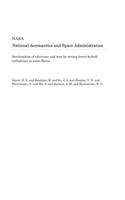
Acceleration of Electrons and Ions by Strong Lower-Hybrid Turbulence in Solar Flares
Series:
One of the outstanding problems in solar flare theory is how to explain the 10-20 keV and greater hard x-ray emissions by a thick target bremsstrahlung model. The model requires the acceleration mechanism to accelerate approximately 10(exp 35) electrons sec(exp -l) with comparable energies, without producing a large return current which persists for long time scales after the beam ceases to exist
NaN
VOLUME
English
Paperback

One of the outstanding problems in solar flare theory is how to explain the 10-20 keV and greater hard x-ray emissions by a thick target bremsstrahlung model. The model requires the acceleration mechanism to accelerate approximately 10(exp 35) electrons sec(exp -l) with comparable energies, without producing a large return current which persists for long time scales after the beam ceases to exist due to Lenz's law, thereby, producing a self-magnetic field of order a few mega-Gauss. In this paper, we investigate particle acceleration resulting from the relaxation of unstable ion ring distributions, producing strong wave activity at the lower hybrid frequency. It is shown that strong lower hybrid wave turbulence collapses in configuration space producing density cavities containing intense electrostatic lower hybrid wave activity. The collapse of these intense nonlinear wave packets saturate by particle acceleration producing energetic electron and ion tails. There are several mechanisms whereby unstable ion distributions could be formed in the solar atmosphere, including reflection at perpendicular shocks, tearing modes, and loss cone depletion. Numerical simulations of ion ring relaxation processes, obtained using a 2 1/2-D fully electromagnetic, relativistic particle in cell code are discussed. We apply the results to the problem of explaining energetic particle production in solar flares. The results show the simultaneous acceleration of both electrons and ions to very high energies: electrons are accelerated to energies in the range 10-500 keV, while ions are accelerated to energies of the order of MeVs, giving rise to x-ray emission and gamma-ray emission respectively. Our simulations also show wave generation at the electron cyclotron frequency. We suggest that these waves are the solar millisecond radio spikes. The strong turbulence collapse process leads to a highly filamented plasma producing many localized regions for particle acceleration and resulting in ...
Price Comparison [India]
In This Series
Bestseller Manga
Trending NEWS




















